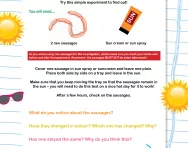Important update from TheSchoolRun
For the past 13 years, TheSchoolRun has been run by a small team of mums working from home, dedicated to providing quality educational resources to primary school parents. Unfortunately, rising supplier costs and falling revenue have made it impossible for us to continue operating, and we’ve had to make the difficult decision to close. The good news: We’ve arranged for another educational provider to take over many of our resources. These will be hosted on a new portal, where the content will be updated and expanded to support your child’s learning.
What this means for subscribers:
- Your subscription is still active, and for now, you can keep using the website as normal — just log in with your usual details to access all our articles and resources*.
- In a few months, all resources will move to the new portal. You’ll continue to have access there until your subscription ends. We’ll send you full details nearer the time.
- As a thank you for your support, we’ll also be sending you 16 primary school eBooks (worth £108.84) to download and keep.
A few changes to be aware of:
- The Learning Journey weekly email has ended, but your child’s plan will still be updated on your dashboard each Monday. Just log in to see the recommended worksheets.
- The 11+ weekly emails have now ended. We sent you all the remaining emails in the series at the end of March — please check your inbox (and spam folder) if you haven’t seen them. You can also follow the full programme here: 11+ Learning Journey.
If you have any questions, please contact us at [email protected]. Thank you for being part of our journey it’s been a privilege to support your family’s learning.
*If you need to reset your password, it will still work as usual. Please check your spam folder if the reset email doesn’t appear in your inbox.
Sun safety in primary schools

When the temperature soars, keeping your child safe in the sun becomes a priority for every parent. But often, there’s some confusion about how schools handle the issue of sun safety, particularly when it comes to the use of sunscreen.
Children spend around eight hours per week outside at school, and this outdoor time typically coincides with the hottest part of the day: 11am until 3pm.


Claim Your Summer Challenges Pack!
- 30 exciting challenges
- Weird and wonderful facts
- Keep them busy the whole summer!
Without adequate protection, their delicate skin can burn in just minutes, which can significantly increase the chances of them developing skin cancer later in life.
‘Sun safety has to be regarded as a serious health and safety concern, and as schools are looking after our children, we have the right to make sure they’re protected,’ says Kathryn Clifford of Skcin: the Karen Clifford Skin Cancer Charity.
What does the law say about the use of sunscreen in schools?
There’s often some misunderstanding around the use of sunscreen in primary schools. Some ask parents to apply it to their child before school; others ask that a bottle is sent in to be applied during the day. Some state that they aren’t allowed to help children apply it, due to the risk of allergies or allegations of abuse; others are happy to do so.
By law, schools are allowed to apply sunscreen to children. The Health and Safety Executive (HSE) states that, ‘health and safety legislation does not prevent school staff from applying or helping pupils apply sun cream. The Department for Education has already made clear that schools are expected to take a sensible approach to this issue.’
NICE, the National Institute for Health and Care Excellence, backs this up, identifying children as an at-risk group for sun damage. Its guidance says head teachers should take action to protect children from over-exposure to UV rays, and that schools should develop a policy to ensure they are protected as much as possible when they’re outside for more than a brief period in strong sunlight.
Legally, schools can, then, ask parents to supply sunscreen for use during the day, and help children apply it if necessary. But teaching union the NUT has published advice that contradicts this position.
It says, ‘The NUT advises teachers not to apply sunscreen to pupils due to the potential for allegations of abuse and, in particular, the time it would take to apply sunscreen to a class of pupils prior to breaktime or lunchtime… If schools decide to allow staff to apply sunscreen to pupils, parental consent should be obtained. Teachers and other staff who do wish to do so should only apply the sunscreen to the face, neck and arms of pupils.’
This leaves both parents and schools unclear as to what they can and can’t do. But Skcin states that schools should not pass the responsibility of sunscreen application to the parent or guardian before a child goes to school, without further protection being accessible throughout the day.
‘This is because sunscreen applied in the morning before school will become ineffective by around 10/11am, leaving a child’s skin unprotected during the hottest time of the day (between 11am and 3pm),’ says Kathryn. ‘Sunscreen should be reapplied at least every two hours to provide adequate protection. This requires a practical approach toward the application of sunscreen in schools, particularly with younger or less able children.’
What should a sun safety policy say?
Skcin’s Sun Safe Schools initiative is encouraging all schools to have a clear policy explaining their approach to providing and/or applying sunscreen. To become an accredited school, they have to:
- Actively remind parents to ensure their child brings a quality sunscreen to school or leaves their sunscreen at school for application as required, OR
- Make sunscreen available for the whole school that is kept at school to ensure every child has access to quality sunscreen on a daily basis.
- Make additional sunscreen available for all outdoor activities, events and school trips where children may have lost, forgotten or run out of theirs.
- Actively encourage children to apply sunscreen when UV levels reach 3 or above before extended periods outdoors, such as lunch breaks, PE or other outdoor activities.
- Take a practical approach toward the application of sunscreen, with assistance provided only where necessary, unless instructed otherwise by the parent.
There are additional criteria surrounding sun protection, such as the wearing of hats and provision of shade, but the above points cover a school’s responsibilities surrounding sunscreen.
‘It’s your right as a parent to ask your child’s school to produce a sun safety policy,’ says Kathryn. Visit Sun Safe Schools for more information about how your child's school can become accredited.
Are once-a-day sunscreens effective enough?
Many parents who are unsure about their school’s approach to sunscreen choose to use a once-a-day cream before their child goes to school. But research by Which? suggests that they are not fully effective, and that a sunscreen with an SPF of 30 could drop to just 8 during the day.
‘We wouldn’t recommend so-called all-day sunscreens, because you can’t control factors like how much your child sweats during the day, or whether it has rubbed off on towels or clothing,’ explains Kathryn.
‘We advise using a sunscreen with an SPF of at least 30 and a UVA rating of four or, ideally, five stars, and reapplying it every two hours.’
At what age should children learn to apply their own sunscreen?
Many schools encourage children to apply their own sunscreen to get around the thorny issue of teachers having physical contact with pupils. Skcin advocates this approach.
‘Teaching children to apply their sunscreen has got to be easier than teaching them to read and write,’ explains Kathryn. ‘Parents can be encouraged to teach their children how to do this.’
The NUT says that most children should be capable of applying their own sunscreen under supervision, except for the very young or those with additional needs.
It’s a good idea to teach your child to apply their own sunscreen once they’re of school age, encouraging them to cover any exposed areas of skin. There are various different child-friendly formulations that may help your child, such as roll-ons, sprays and mousse.
It’s also important to teach your child the other basics of sun safety, such as wearing a broad brimmed hat and seeking shade at the hottest time of the day.
What should you do if your child gets sunburnt at school?
Shockingly, almost 40% of children have been sunburnt at school. If this happens to your child, take the following steps:
- Get them out of the sun as soon as possible.
- Cool their skin by giving them a cool bath or shower, or putting cold flannels on the affected area.
- Use an after-sun lotion containing aloe vera.
- Give them plenty of cool fluids to drink.
- Give them children’s paracetamol or ibuprofen for the pain.
‘It’s also important to draw the school’s attention to what has happened,’ advises Kathryn. ‘Ask if they have a sun safety policy, and if so, ask whether it was followed. Ultimately, schools and parents need to work together to reduce the risk of sun damage and ensure children are protected.’
More information about sun safety for families
The booklet Sun Safety & Skin Cancer offers a wealth of potentially life-saving information about the risks of UV, how to prevent skin cancer, how to protect children, how to check your skin for signs of change and what to look out for. Read it online on the Sun Safe Schools website.









